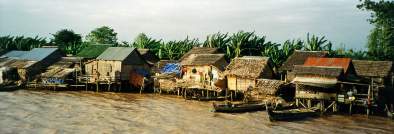The Mekong River is the world's 10th longest river. Its estimated length is 4,909 km (3,050 mi), and it drains an area of 795,000 km2 (307,000 sq mi), discharging 475 km3 (114 cu mi) of water annually. 65 million people currently live and rely upon the Mekong for their sustenance and livelihood. It runs through China, Burma, Laos, Thailand, Cambodia and Vietnam. The Mekong basin is one of the richest areas of biodiversity in the world, providing a habitat for over 1,300 species of fish.
The extreme seasonal variations in flow and the presence of rapids and waterfalls make navigation difficult. The large number of dams in the river is one of the major issues threatening the ecosystem and livelihoods dependent on the river. The construction of new dams will impact nations downstream and the environment which will suffer from added pollution and river blockage problems as fish cannot swim upstream, and potentially decreasing water flow.
Climate change will make things worse. GWP Cambodia therefore organised a workshop to build awareness around the increasing risks of climate change on May 26, 2011, in Kampong Cham province, with participants from national and provincial agencies, academic institutes and NGOs.
The main objectives of the workshop were:
1) To introduce the concept of climate change and debate the current status of climate change management in Cambodia and to identify critical risks affecting different sectors, encouraging participants to share experiences and lessons learned from different sectors.
2) To discuss how the IWRM approach is applicable for climate change adaptation and mitigation for water resources management and development, especially for basin development planning processes.
Presentations and discussions included the following topics:
• Climate change impact in the Mekong River Basin and the application of IWRM as a tool for adaptation and mitigation.
• State of climate change management in Cambodia.
• Planning and application of climate change adaptation by the Ministry of Water Resources and Meteorology (MOWRAM) illustrating five strategies for adaptation: water resources management and development; flood and draught management; preparation of a draft law and regulations for sustainable use of water and related resources; information management on water resources and meteorology; and reforming of administrative management and human resources development.
• Presentation by the Ministry of Environment indicating that by 2100 in Cambodia there could be temperature increases of 1.350C to 2.50C and rainfall increases of 3% to 35%.
• Farmer’s vulnerability to natural, social and economic impacts imposed by climate change. Natural impacts include: drought, flood (or heavy rain), faster decrease of the water level in the Mekong River in the dry season, low fisheries production, seawater temperature increase, etc. Social and economic impacts: insufficient water resources, use of inappropriate fertilizers, low agricultural production, etc.
The participants agreed that:
• The IWRM-based Basin Development Plan will support Climate Change Adaptation and Mitigation (CCAM).
• The participation of stakeholders is important. Knowledge must be improved to increase understanding relevant to decision making.
• A basin plan is complex and CCAM is needed.
• IWRM is the tool for CCAM, but a clearer process and more understanding among stakeholders on its application is required.

